ITECH7402: Analyzing Ethical Dilemmas and SFIA Framework Report
VerifiedAdded on 2023/06/07
|15
|2488
|264
Report
AI Summary
This report presents an ethical case study analysis, evaluating the decisions of Mr. McBright and Mrs. McDonald using ethical models and the ACS code of professional conduct. It identifies stakeholders and their ethical dilemmas, focusing on Mrs. McDonald's decision to release a product with a known bug. The report further explores the Skills Framework for the Information Age (SFIA), providing a reflective interpretation and justification of responsibility levels and skill sets for career development in the IT field. It concludes by highlighting the importance of ethical considerations and skills development for IT professionals. Desklib offers this assignment as a resource for students, along with other study tools and solved papers.
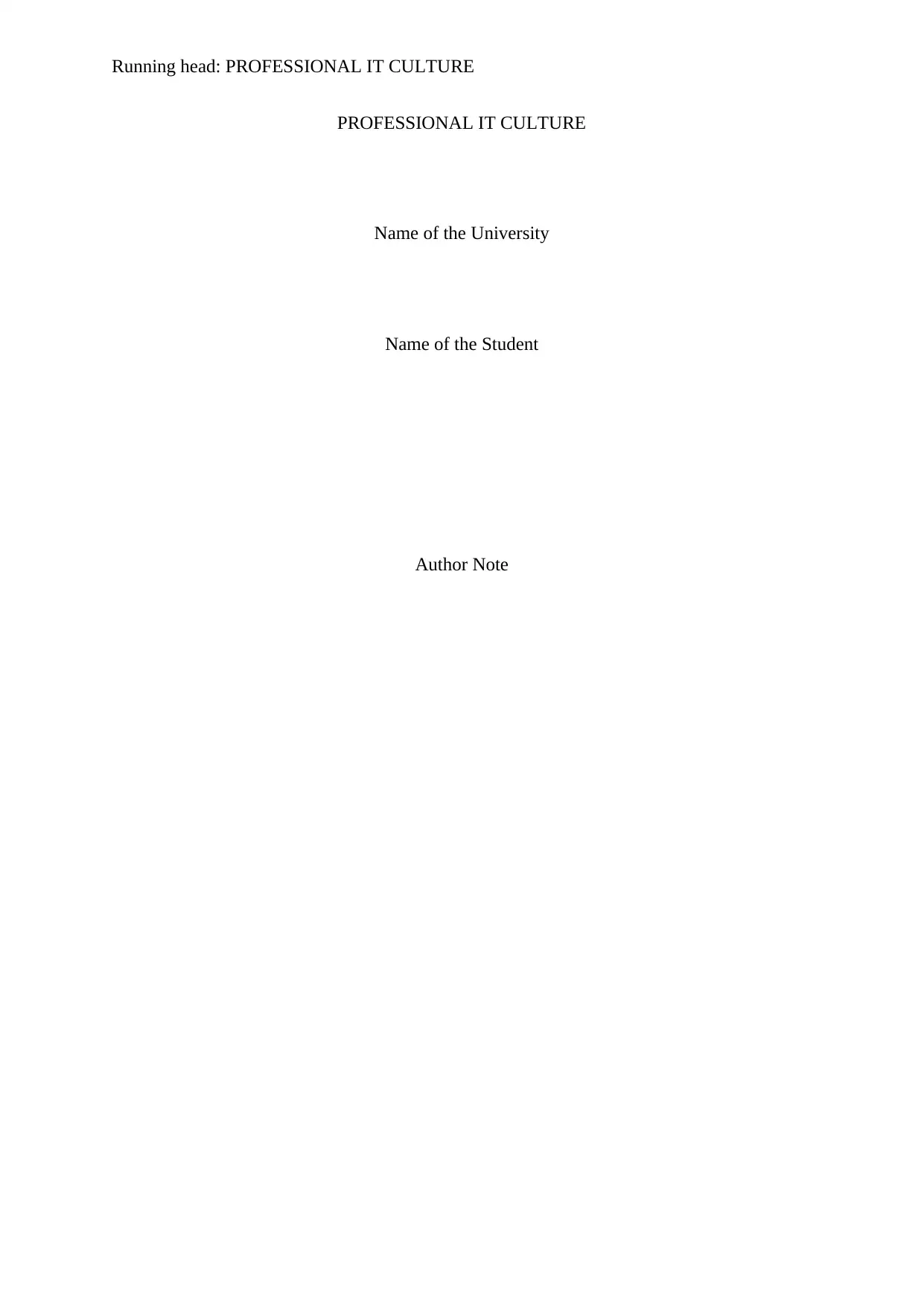
Running head: PROFESSIONAL IT CULTURE
PROFESSIONAL IT CULTURE
Name of the University
Name of the Student
Author Note
PROFESSIONAL IT CULTURE
Name of the University
Name of the Student
Author Note
Paraphrase This Document
Need a fresh take? Get an instant paraphrase of this document with our AI Paraphraser
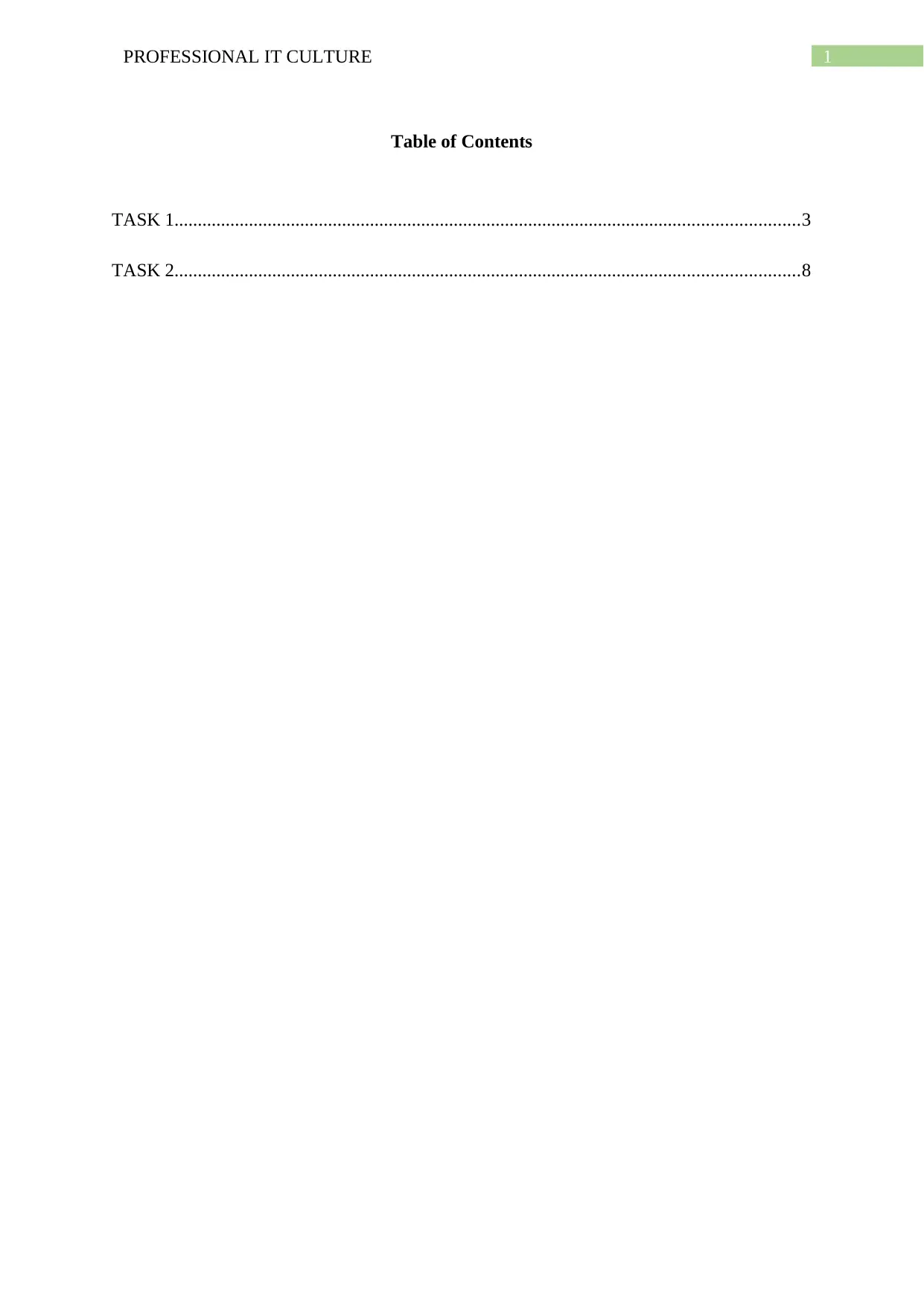
1PROFESSIONAL IT CULTURE
Table of Contents
TASK 1......................................................................................................................................3
TASK 2......................................................................................................................................8
Table of Contents
TASK 1......................................................................................................................................3
TASK 2......................................................................................................................................8
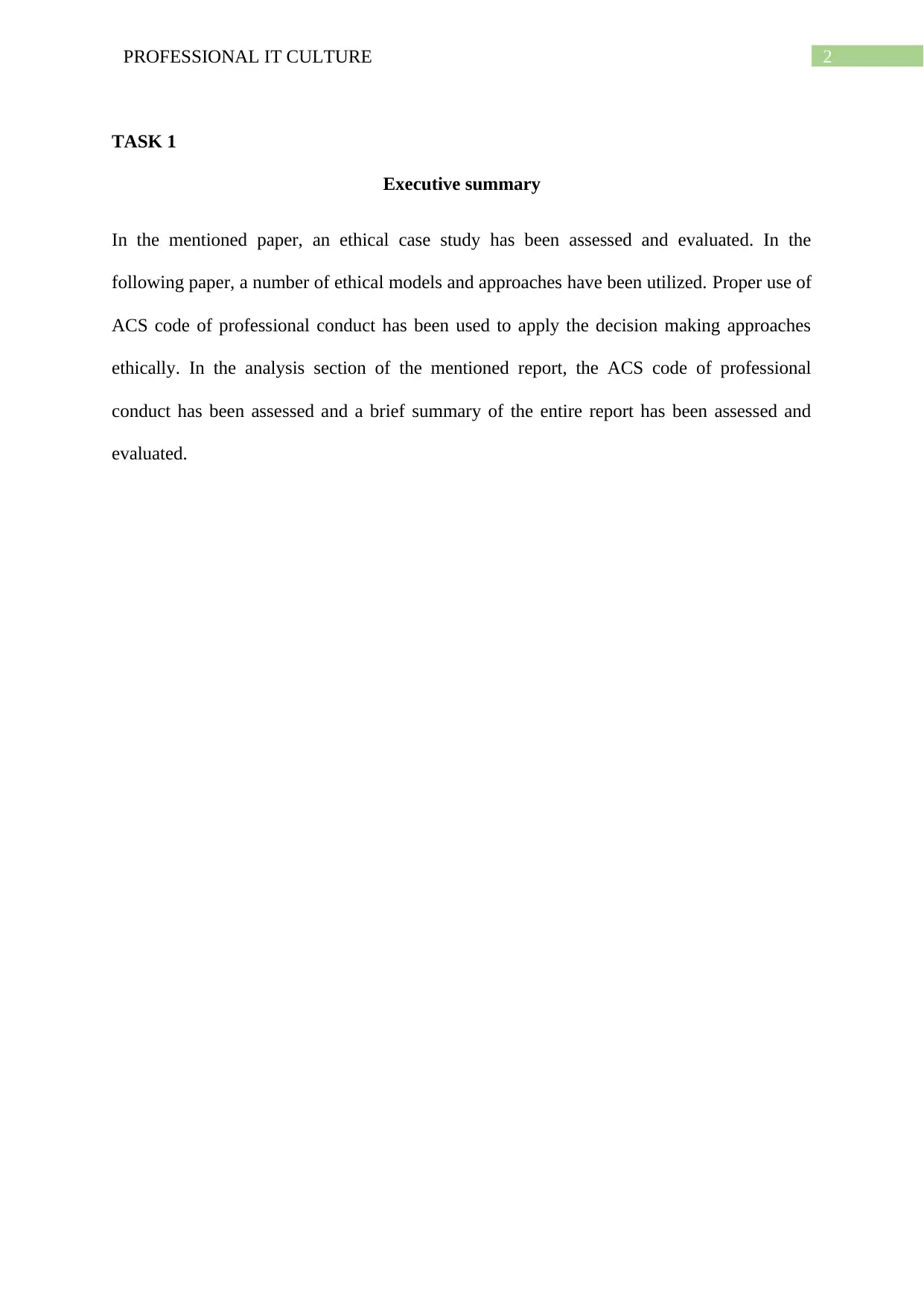
2PROFESSIONAL IT CULTURE
TASK 1
Executive summary
In the mentioned paper, an ethical case study has been assessed and evaluated. In the
following paper, a number of ethical models and approaches have been utilized. Proper use of
ACS code of professional conduct has been used to apply the decision making approaches
ethically. In the analysis section of the mentioned report, the ACS code of professional
conduct has been assessed and a brief summary of the entire report has been assessed and
evaluated.
TASK 1
Executive summary
In the mentioned paper, an ethical case study has been assessed and evaluated. In the
following paper, a number of ethical models and approaches have been utilized. Proper use of
ACS code of professional conduct has been used to apply the decision making approaches
ethically. In the analysis section of the mentioned report, the ACS code of professional
conduct has been assessed and a brief summary of the entire report has been assessed and
evaluated.
⊘ This is a preview!⊘
Do you want full access?
Subscribe today to unlock all pages.

Trusted by 1+ million students worldwide
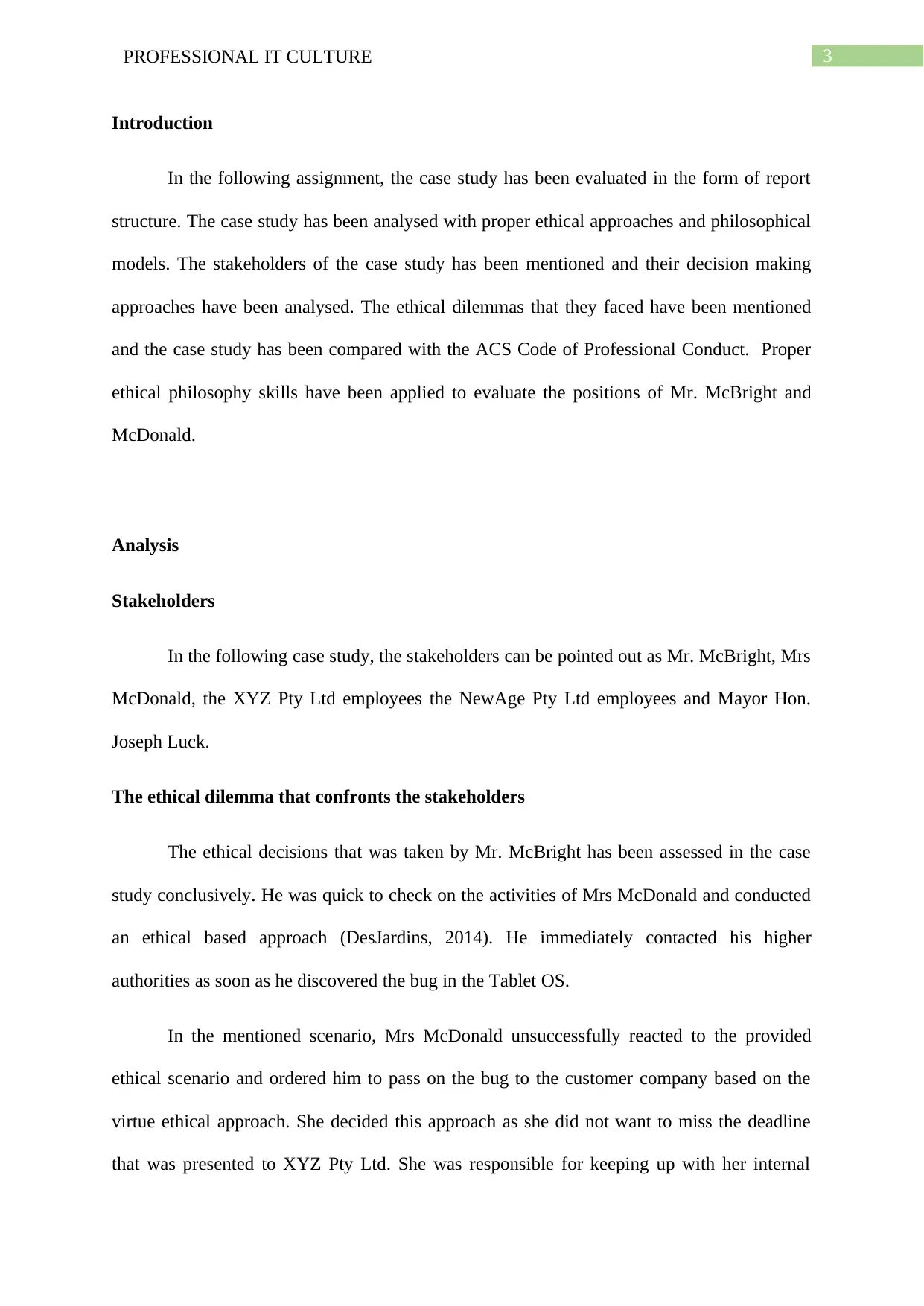
3PROFESSIONAL IT CULTURE
Introduction
In the following assignment, the case study has been evaluated in the form of report
structure. The case study has been analysed with proper ethical approaches and philosophical
models. The stakeholders of the case study has been mentioned and their decision making
approaches have been analysed. The ethical dilemmas that they faced have been mentioned
and the case study has been compared with the ACS Code of Professional Conduct. Proper
ethical philosophy skills have been applied to evaluate the positions of Mr. McBright and
McDonald.
Analysis
Stakeholders
In the following case study, the stakeholders can be pointed out as Mr. McBright, Mrs
McDonald, the XYZ Pty Ltd employees the NewAge Pty Ltd employees and Mayor Hon.
Joseph Luck.
The ethical dilemma that confronts the stakeholders
The ethical decisions that was taken by Mr. McBright has been assessed in the case
study conclusively. He was quick to check on the activities of Mrs McDonald and conducted
an ethical based approach (DesJardins, 2014). He immediately contacted his higher
authorities as soon as he discovered the bug in the Tablet OS.
In the mentioned scenario, Mrs McDonald unsuccessfully reacted to the provided
ethical scenario and ordered him to pass on the bug to the customer company based on the
virtue ethical approach. She decided this approach as she did not want to miss the deadline
that was presented to XYZ Pty Ltd. She was responsible for keeping up with her internal
Introduction
In the following assignment, the case study has been evaluated in the form of report
structure. The case study has been analysed with proper ethical approaches and philosophical
models. The stakeholders of the case study has been mentioned and their decision making
approaches have been analysed. The ethical dilemmas that they faced have been mentioned
and the case study has been compared with the ACS Code of Professional Conduct. Proper
ethical philosophy skills have been applied to evaluate the positions of Mr. McBright and
McDonald.
Analysis
Stakeholders
In the following case study, the stakeholders can be pointed out as Mr. McBright, Mrs
McDonald, the XYZ Pty Ltd employees the NewAge Pty Ltd employees and Mayor Hon.
Joseph Luck.
The ethical dilemma that confronts the stakeholders
The ethical decisions that was taken by Mr. McBright has been assessed in the case
study conclusively. He was quick to check on the activities of Mrs McDonald and conducted
an ethical based approach (DesJardins, 2014). He immediately contacted his higher
authorities as soon as he discovered the bug in the Tablet OS.
In the mentioned scenario, Mrs McDonald unsuccessfully reacted to the provided
ethical scenario and ordered him to pass on the bug to the customer company based on the
virtue ethical approach. She decided this approach as she did not want to miss the deadline
that was presented to XYZ Pty Ltd. She was responsible for keeping up with her internal
Paraphrase This Document
Need a fresh take? Get an instant paraphrase of this document with our AI Paraphraser
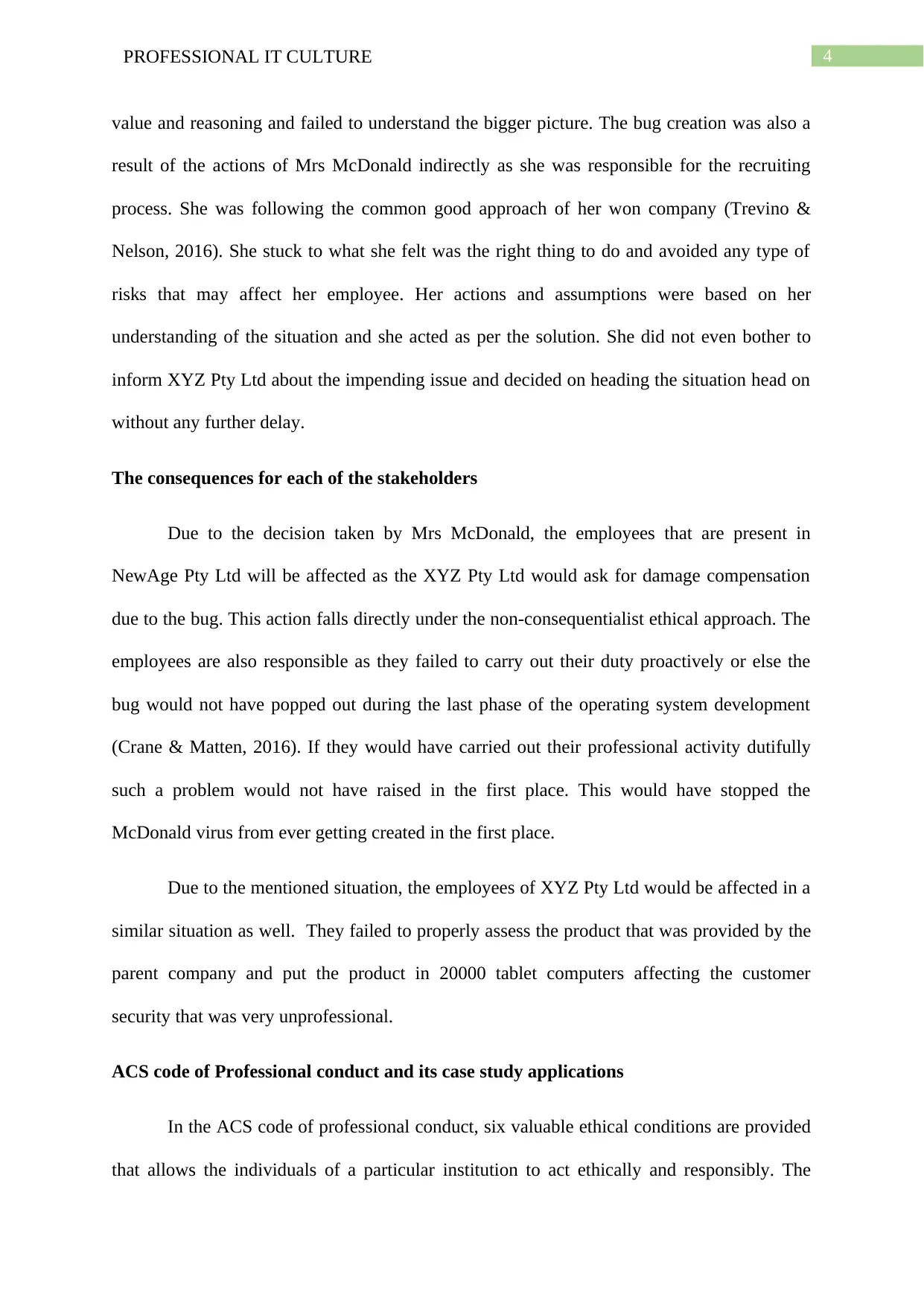
4PROFESSIONAL IT CULTURE
value and reasoning and failed to understand the bigger picture. The bug creation was also a
result of the actions of Mrs McDonald indirectly as she was responsible for the recruiting
process. She was following the common good approach of her won company (Trevino &
Nelson, 2016). She stuck to what she felt was the right thing to do and avoided any type of
risks that may affect her employee. Her actions and assumptions were based on her
understanding of the situation and she acted as per the solution. She did not even bother to
inform XYZ Pty Ltd about the impending issue and decided on heading the situation head on
without any further delay.
The consequences for each of the stakeholders
Due to the decision taken by Mrs McDonald, the employees that are present in
NewAge Pty Ltd will be affected as the XYZ Pty Ltd would ask for damage compensation
due to the bug. This action falls directly under the non-consequentialist ethical approach. The
employees are also responsible as they failed to carry out their duty proactively or else the
bug would not have popped out during the last phase of the operating system development
(Crane & Matten, 2016). If they would have carried out their professional activity dutifully
such a problem would not have raised in the first place. This would have stopped the
McDonald virus from ever getting created in the first place.
Due to the mentioned situation, the employees of XYZ Pty Ltd would be affected in a
similar situation as well. They failed to properly assess the product that was provided by the
parent company and put the product in 20000 tablet computers affecting the customer
security that was very unprofessional.
ACS code of Professional conduct and its case study applications
In the ACS code of professional conduct, six valuable ethical conditions are provided
that allows the individuals of a particular institution to act ethically and responsibly. The
value and reasoning and failed to understand the bigger picture. The bug creation was also a
result of the actions of Mrs McDonald indirectly as she was responsible for the recruiting
process. She was following the common good approach of her won company (Trevino &
Nelson, 2016). She stuck to what she felt was the right thing to do and avoided any type of
risks that may affect her employee. Her actions and assumptions were based on her
understanding of the situation and she acted as per the solution. She did not even bother to
inform XYZ Pty Ltd about the impending issue and decided on heading the situation head on
without any further delay.
The consequences for each of the stakeholders
Due to the decision taken by Mrs McDonald, the employees that are present in
NewAge Pty Ltd will be affected as the XYZ Pty Ltd would ask for damage compensation
due to the bug. This action falls directly under the non-consequentialist ethical approach. The
employees are also responsible as they failed to carry out their duty proactively or else the
bug would not have popped out during the last phase of the operating system development
(Crane & Matten, 2016). If they would have carried out their professional activity dutifully
such a problem would not have raised in the first place. This would have stopped the
McDonald virus from ever getting created in the first place.
Due to the mentioned situation, the employees of XYZ Pty Ltd would be affected in a
similar situation as well. They failed to properly assess the product that was provided by the
parent company and put the product in 20000 tablet computers affecting the customer
security that was very unprofessional.
ACS code of Professional conduct and its case study applications
In the ACS code of professional conduct, six valuable ethical conditions are provided
that allows the individuals of a particular institution to act ethically and responsibly. The
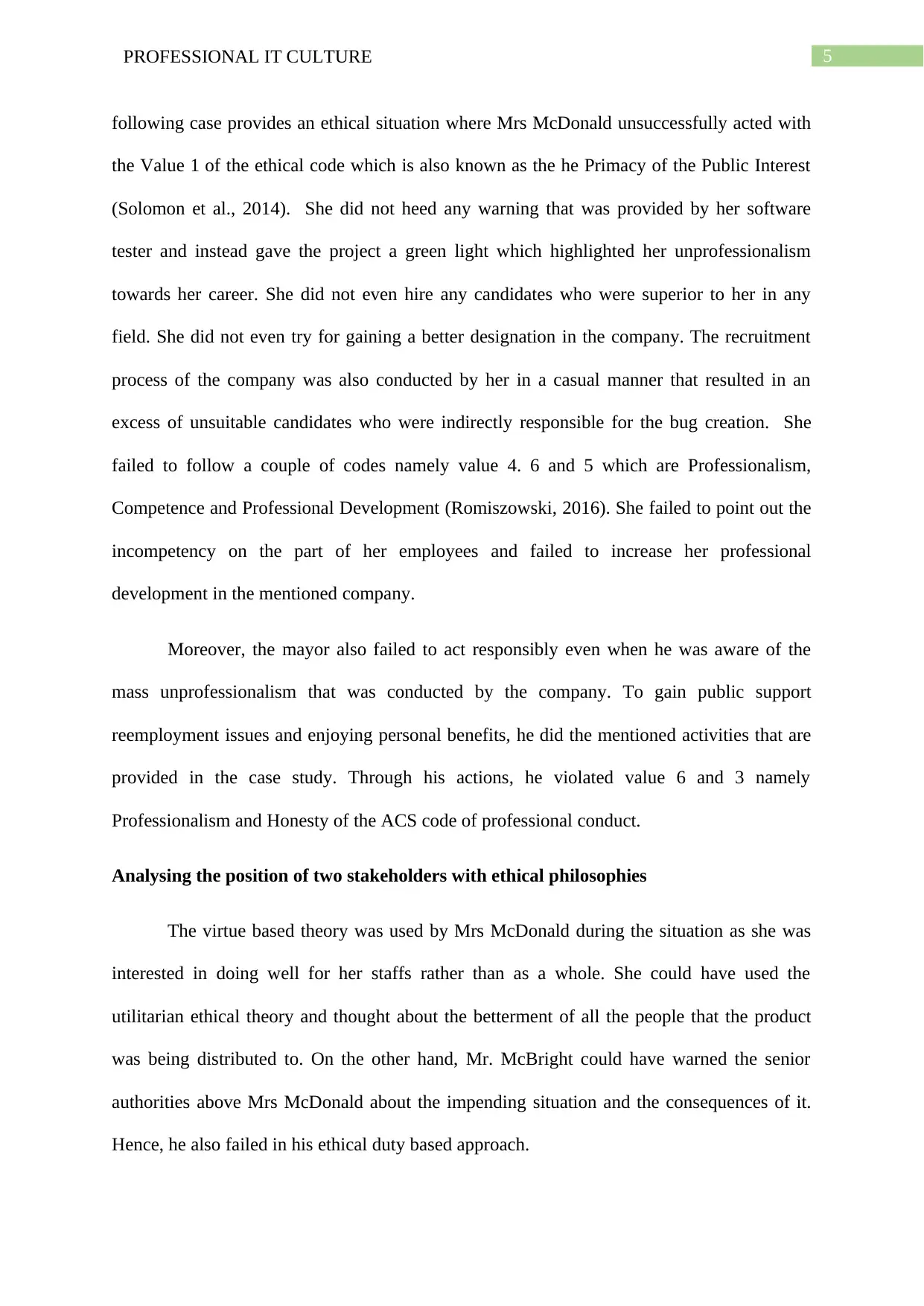
5PROFESSIONAL IT CULTURE
following case provides an ethical situation where Mrs McDonald unsuccessfully acted with
the Value 1 of the ethical code which is also known as the he Primacy of the Public Interest
(Solomon et al., 2014). She did not heed any warning that was provided by her software
tester and instead gave the project a green light which highlighted her unprofessionalism
towards her career. She did not even hire any candidates who were superior to her in any
field. She did not even try for gaining a better designation in the company. The recruitment
process of the company was also conducted by her in a casual manner that resulted in an
excess of unsuitable candidates who were indirectly responsible for the bug creation. She
failed to follow a couple of codes namely value 4. 6 and 5 which are Professionalism,
Competence and Professional Development (Romiszowski, 2016). She failed to point out the
incompetency on the part of her employees and failed to increase her professional
development in the mentioned company.
Moreover, the mayor also failed to act responsibly even when he was aware of the
mass unprofessionalism that was conducted by the company. To gain public support
reemployment issues and enjoying personal benefits, he did the mentioned activities that are
provided in the case study. Through his actions, he violated value 6 and 3 namely
Professionalism and Honesty of the ACS code of professional conduct.
Analysing the position of two stakeholders with ethical philosophies
The virtue based theory was used by Mrs McDonald during the situation as she was
interested in doing well for her staffs rather than as a whole. She could have used the
utilitarian ethical theory and thought about the betterment of all the people that the product
was being distributed to. On the other hand, Mr. McBright could have warned the senior
authorities above Mrs McDonald about the impending situation and the consequences of it.
Hence, he also failed in his ethical duty based approach.
following case provides an ethical situation where Mrs McDonald unsuccessfully acted with
the Value 1 of the ethical code which is also known as the he Primacy of the Public Interest
(Solomon et al., 2014). She did not heed any warning that was provided by her software
tester and instead gave the project a green light which highlighted her unprofessionalism
towards her career. She did not even hire any candidates who were superior to her in any
field. She did not even try for gaining a better designation in the company. The recruitment
process of the company was also conducted by her in a casual manner that resulted in an
excess of unsuitable candidates who were indirectly responsible for the bug creation. She
failed to follow a couple of codes namely value 4. 6 and 5 which are Professionalism,
Competence and Professional Development (Romiszowski, 2016). She failed to point out the
incompetency on the part of her employees and failed to increase her professional
development in the mentioned company.
Moreover, the mayor also failed to act responsibly even when he was aware of the
mass unprofessionalism that was conducted by the company. To gain public support
reemployment issues and enjoying personal benefits, he did the mentioned activities that are
provided in the case study. Through his actions, he violated value 6 and 3 namely
Professionalism and Honesty of the ACS code of professional conduct.
Analysing the position of two stakeholders with ethical philosophies
The virtue based theory was used by Mrs McDonald during the situation as she was
interested in doing well for her staffs rather than as a whole. She could have used the
utilitarian ethical theory and thought about the betterment of all the people that the product
was being distributed to. On the other hand, Mr. McBright could have warned the senior
authorities above Mrs McDonald about the impending situation and the consequences of it.
Hence, he also failed in his ethical duty based approach.
⊘ This is a preview!⊘
Do you want full access?
Subscribe today to unlock all pages.

Trusted by 1+ million students worldwide
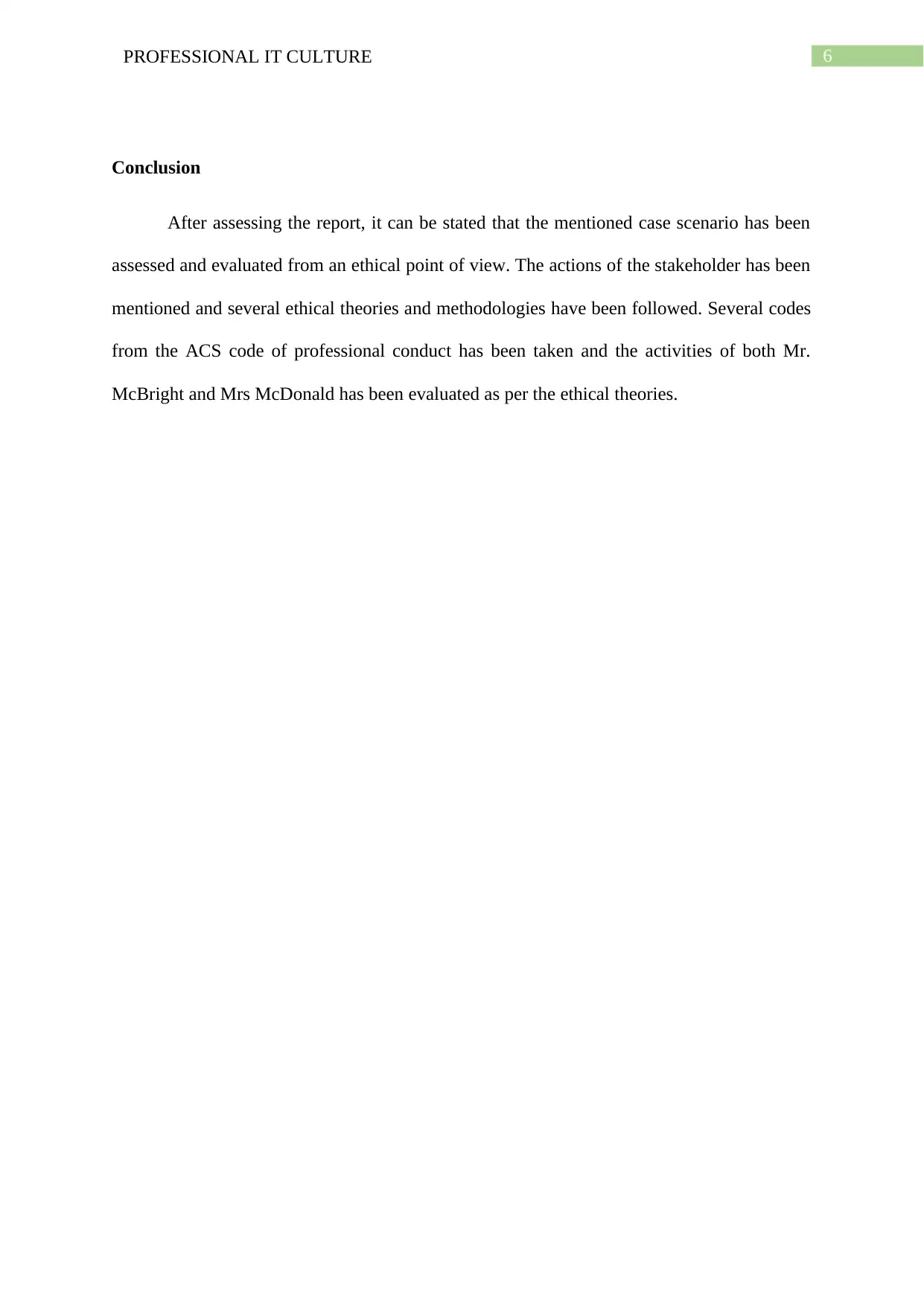
6PROFESSIONAL IT CULTURE
Conclusion
After assessing the report, it can be stated that the mentioned case scenario has been
assessed and evaluated from an ethical point of view. The actions of the stakeholder has been
mentioned and several ethical theories and methodologies have been followed. Several codes
from the ACS code of professional conduct has been taken and the activities of both Mr.
McBright and Mrs McDonald has been evaluated as per the ethical theories.
Conclusion
After assessing the report, it can be stated that the mentioned case scenario has been
assessed and evaluated from an ethical point of view. The actions of the stakeholder has been
mentioned and several ethical theories and methodologies have been followed. Several codes
from the ACS code of professional conduct has been taken and the activities of both Mr.
McBright and Mrs McDonald has been evaluated as per the ethical theories.
Paraphrase This Document
Need a fresh take? Get an instant paraphrase of this document with our AI Paraphraser
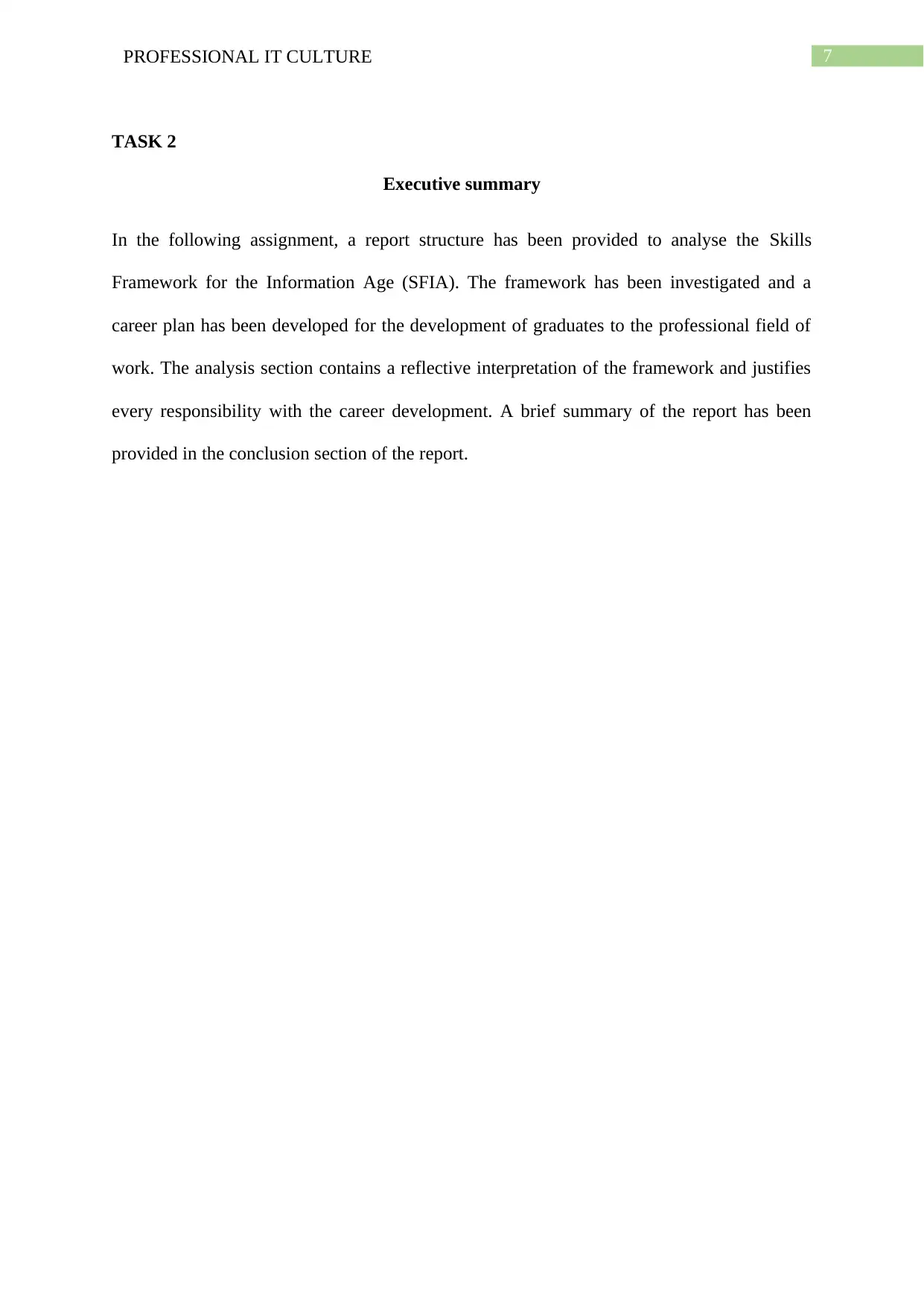
7PROFESSIONAL IT CULTURE
TASK 2
Executive summary
In the following assignment, a report structure has been provided to analyse the Skills
Framework for the Information Age (SFIA). The framework has been investigated and a
career plan has been developed for the development of graduates to the professional field of
work. The analysis section contains a reflective interpretation of the framework and justifies
every responsibility with the career development. A brief summary of the report has been
provided in the conclusion section of the report.
TASK 2
Executive summary
In the following assignment, a report structure has been provided to analyse the Skills
Framework for the Information Age (SFIA). The framework has been investigated and a
career plan has been developed for the development of graduates to the professional field of
work. The analysis section contains a reflective interpretation of the framework and justifies
every responsibility with the career development. A brief summary of the report has been
provided in the conclusion section of the report.
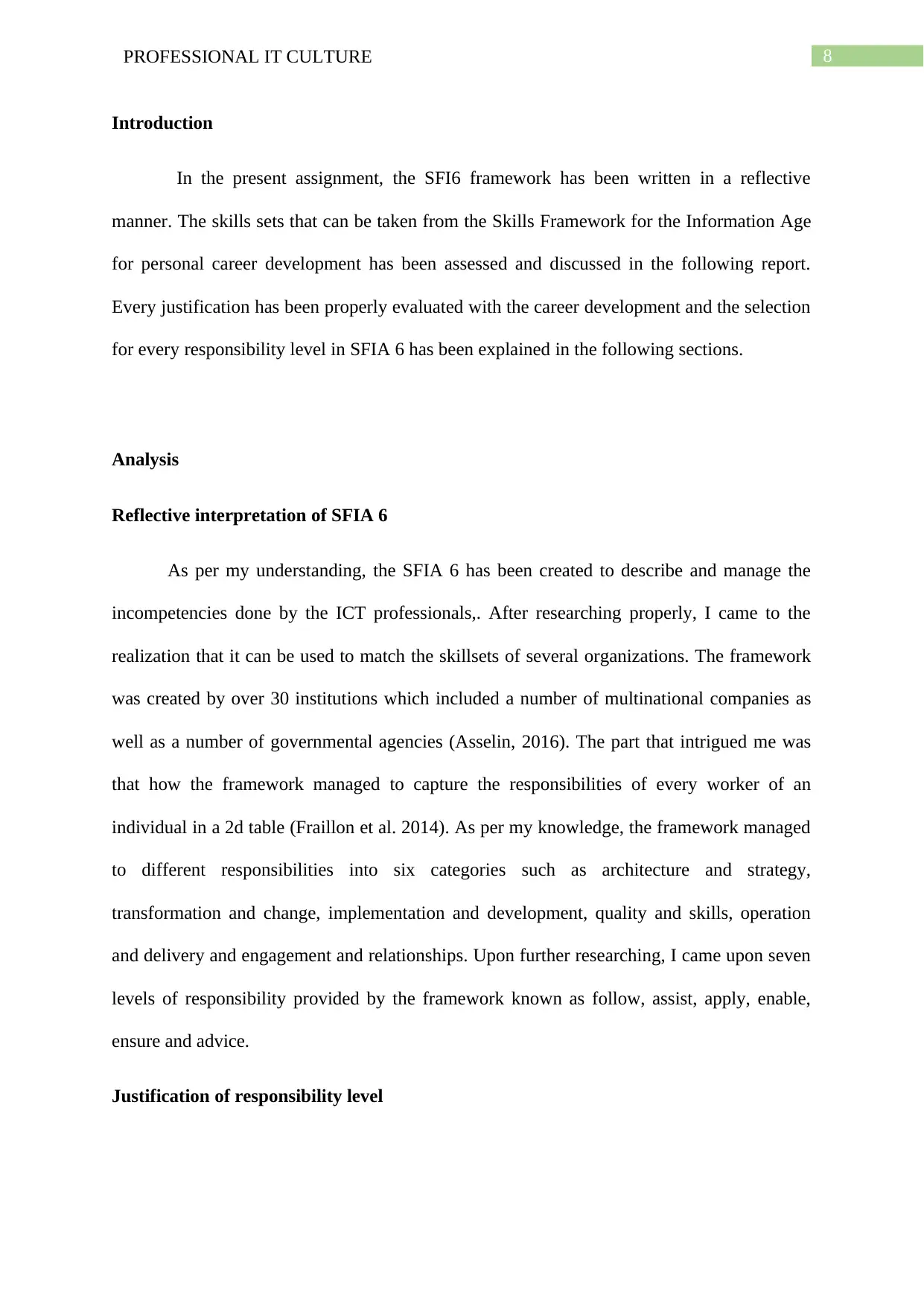
8PROFESSIONAL IT CULTURE
Introduction
In the present assignment, the SFI6 framework has been written in a reflective
manner. The skills sets that can be taken from the Skills Framework for the Information Age
for personal career development has been assessed and discussed in the following report.
Every justification has been properly evaluated with the career development and the selection
for every responsibility level in SFIA 6 has been explained in the following sections.
Analysis
Reflective interpretation of SFIA 6
As per my understanding, the SFIA 6 has been created to describe and manage the
incompetencies done by the ICT professionals,. After researching properly, I came to the
realization that it can be used to match the skillsets of several organizations. The framework
was created by over 30 institutions which included a number of multinational companies as
well as a number of governmental agencies (Asselin, 2016). The part that intrigued me was
that how the framework managed to capture the responsibilities of every worker of an
individual in a 2d table (Fraillon et al. 2014). As per my knowledge, the framework managed
to different responsibilities into six categories such as architecture and strategy,
transformation and change, implementation and development, quality and skills, operation
and delivery and engagement and relationships. Upon further researching, I came upon seven
levels of responsibility provided by the framework known as follow, assist, apply, enable,
ensure and advice.
Justification of responsibility level
Introduction
In the present assignment, the SFI6 framework has been written in a reflective
manner. The skills sets that can be taken from the Skills Framework for the Information Age
for personal career development has been assessed and discussed in the following report.
Every justification has been properly evaluated with the career development and the selection
for every responsibility level in SFIA 6 has been explained in the following sections.
Analysis
Reflective interpretation of SFIA 6
As per my understanding, the SFIA 6 has been created to describe and manage the
incompetencies done by the ICT professionals,. After researching properly, I came to the
realization that it can be used to match the skillsets of several organizations. The framework
was created by over 30 institutions which included a number of multinational companies as
well as a number of governmental agencies (Asselin, 2016). The part that intrigued me was
that how the framework managed to capture the responsibilities of every worker of an
individual in a 2d table (Fraillon et al. 2014). As per my knowledge, the framework managed
to different responsibilities into six categories such as architecture and strategy,
transformation and change, implementation and development, quality and skills, operation
and delivery and engagement and relationships. Upon further researching, I came upon seven
levels of responsibility provided by the framework known as follow, assist, apply, enable,
ensure and advice.
Justification of responsibility level
⊘ This is a preview!⊘
Do you want full access?
Subscribe today to unlock all pages.

Trusted by 1+ million students worldwide
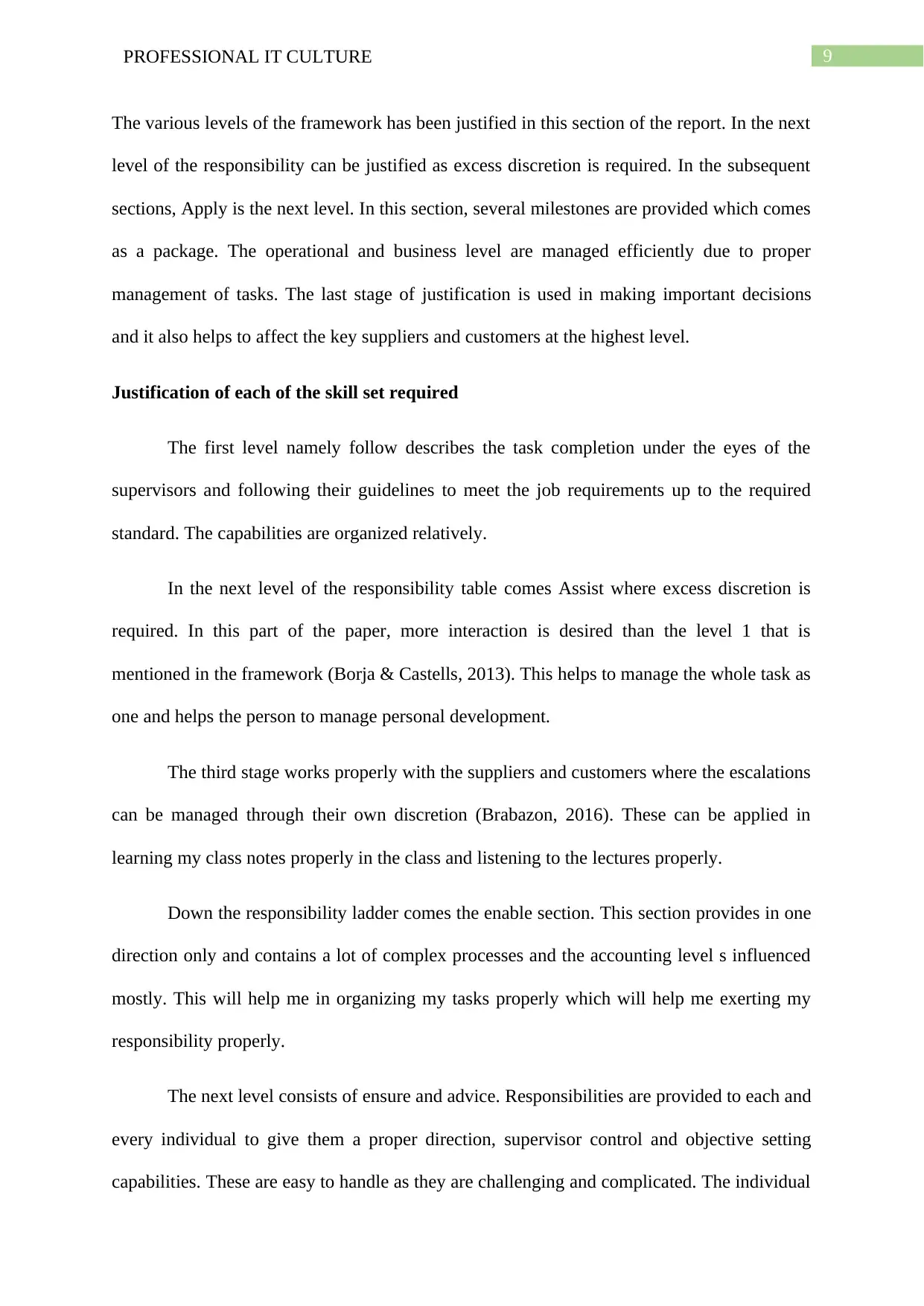
9PROFESSIONAL IT CULTURE
The various levels of the framework has been justified in this section of the report. In the next
level of the responsibility can be justified as excess discretion is required. In the subsequent
sections, Apply is the next level. In this section, several milestones are provided which comes
as a package. The operational and business level are managed efficiently due to proper
management of tasks. The last stage of justification is used in making important decisions
and it also helps to affect the key suppliers and customers at the highest level.
Justification of each of the skill set required
The first level namely follow describes the task completion under the eyes of the
supervisors and following their guidelines to meet the job requirements up to the required
standard. The capabilities are organized relatively.
In the next level of the responsibility table comes Assist where excess discretion is
required. In this part of the paper, more interaction is desired than the level 1 that is
mentioned in the framework (Borja & Castells, 2013). This helps to manage the whole task as
one and helps the person to manage personal development.
The third stage works properly with the suppliers and customers where the escalations
can be managed through their own discretion (Brabazon, 2016). These can be applied in
learning my class notes properly in the class and listening to the lectures properly.
Down the responsibility ladder comes the enable section. This section provides in one
direction only and contains a lot of complex processes and the accounting level s influenced
mostly. This will help me in organizing my tasks properly which will help me exerting my
responsibility properly.
The next level consists of ensure and advice. Responsibilities are provided to each and
every individual to give them a proper direction, supervisor control and objective setting
capabilities. These are easy to handle as they are challenging and complicated. The individual
The various levels of the framework has been justified in this section of the report. In the next
level of the responsibility can be justified as excess discretion is required. In the subsequent
sections, Apply is the next level. In this section, several milestones are provided which comes
as a package. The operational and business level are managed efficiently due to proper
management of tasks. The last stage of justification is used in making important decisions
and it also helps to affect the key suppliers and customers at the highest level.
Justification of each of the skill set required
The first level namely follow describes the task completion under the eyes of the
supervisors and following their guidelines to meet the job requirements up to the required
standard. The capabilities are organized relatively.
In the next level of the responsibility table comes Assist where excess discretion is
required. In this part of the paper, more interaction is desired than the level 1 that is
mentioned in the framework (Borja & Castells, 2013). This helps to manage the whole task as
one and helps the person to manage personal development.
The third stage works properly with the suppliers and customers where the escalations
can be managed through their own discretion (Brabazon, 2016). These can be applied in
learning my class notes properly in the class and listening to the lectures properly.
Down the responsibility ladder comes the enable section. This section provides in one
direction only and contains a lot of complex processes and the accounting level s influenced
mostly. This will help me in organizing my tasks properly which will help me exerting my
responsibility properly.
The next level consists of ensure and advice. Responsibilities are provided to each and
every individual to give them a proper direction, supervisor control and objective setting
capabilities. These are easy to handle as they are challenging and complicated. The individual
Paraphrase This Document
Need a fresh take? Get an instant paraphrase of this document with our AI Paraphraser
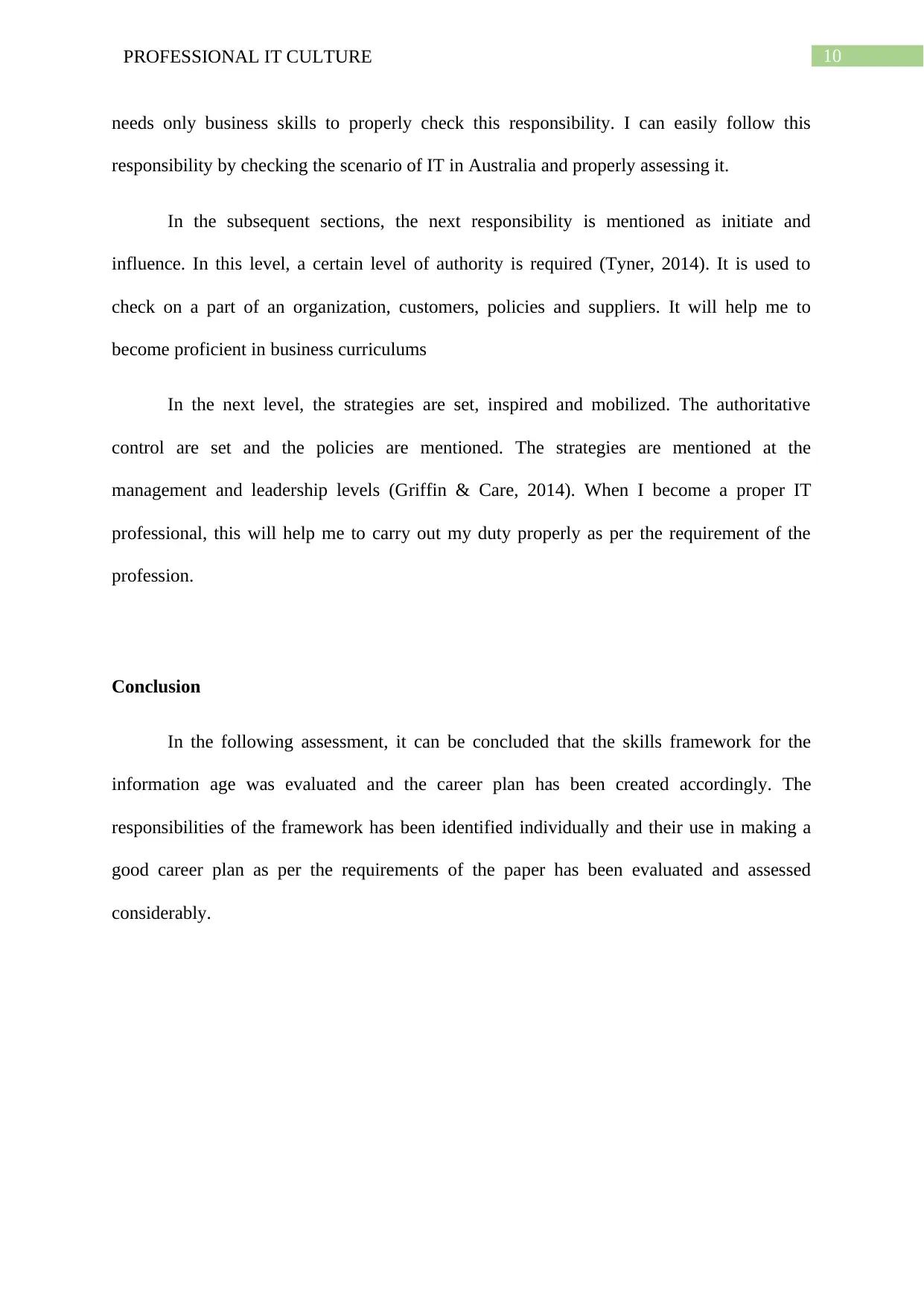
10PROFESSIONAL IT CULTURE
needs only business skills to properly check this responsibility. I can easily follow this
responsibility by checking the scenario of IT in Australia and properly assessing it.
In the subsequent sections, the next responsibility is mentioned as initiate and
influence. In this level, a certain level of authority is required (Tyner, 2014). It is used to
check on a part of an organization, customers, policies and suppliers. It will help me to
become proficient in business curriculums
In the next level, the strategies are set, inspired and mobilized. The authoritative
control are set and the policies are mentioned. The strategies are mentioned at the
management and leadership levels (Griffin & Care, 2014). When I become a proper IT
professional, this will help me to carry out my duty properly as per the requirement of the
profession.
Conclusion
In the following assessment, it can be concluded that the skills framework for the
information age was evaluated and the career plan has been created accordingly. The
responsibilities of the framework has been identified individually and their use in making a
good career plan as per the requirements of the paper has been evaluated and assessed
considerably.
needs only business skills to properly check this responsibility. I can easily follow this
responsibility by checking the scenario of IT in Australia and properly assessing it.
In the subsequent sections, the next responsibility is mentioned as initiate and
influence. In this level, a certain level of authority is required (Tyner, 2014). It is used to
check on a part of an organization, customers, policies and suppliers. It will help me to
become proficient in business curriculums
In the next level, the strategies are set, inspired and mobilized. The authoritative
control are set and the policies are mentioned. The strategies are mentioned at the
management and leadership levels (Griffin & Care, 2014). When I become a proper IT
professional, this will help me to carry out my duty properly as per the requirement of the
profession.
Conclusion
In the following assessment, it can be concluded that the skills framework for the
information age was evaluated and the career plan has been created accordingly. The
responsibilities of the framework has been identified individually and their use in making a
good career plan as per the requirements of the paper has been evaluated and assessed
considerably.
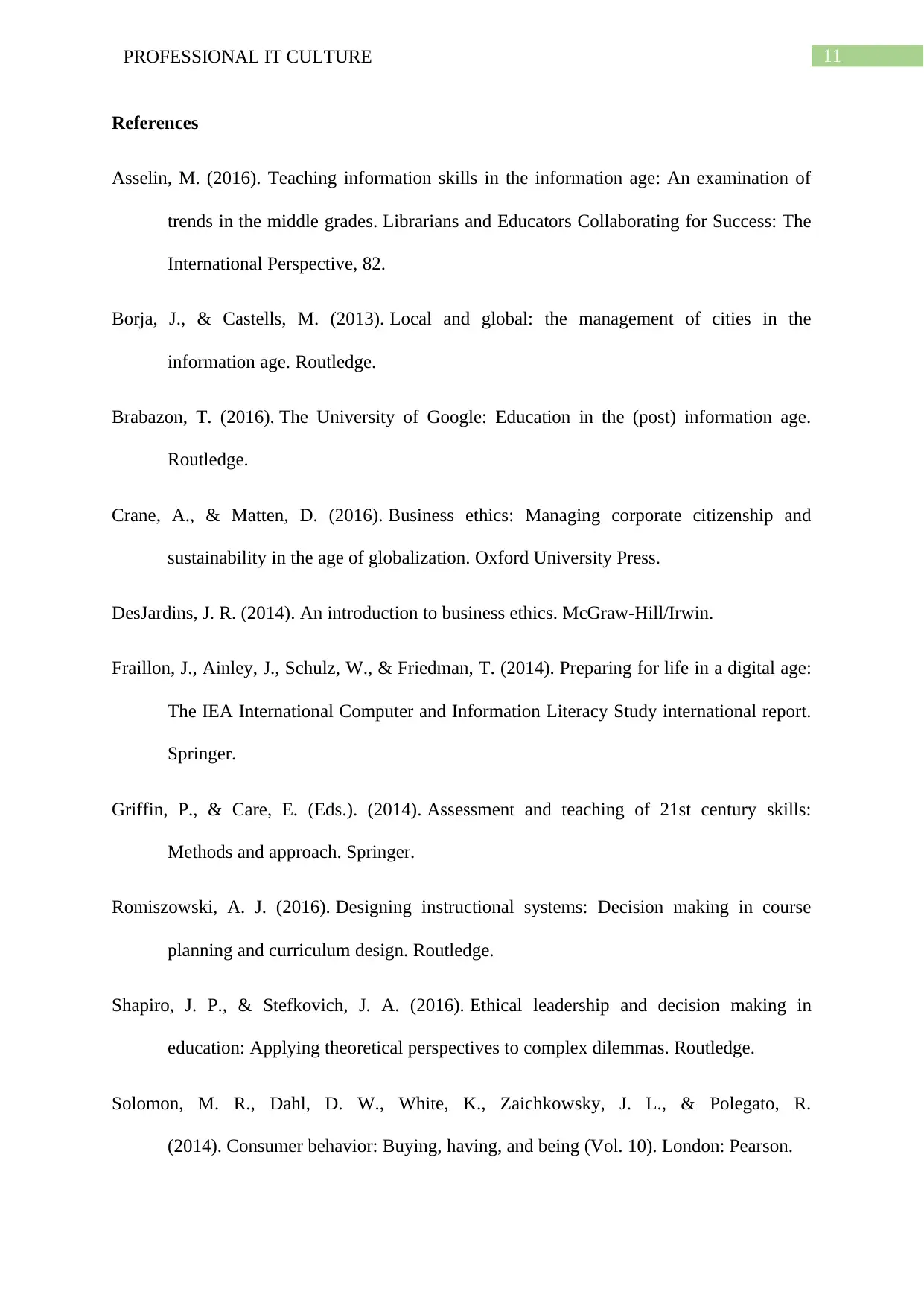
11PROFESSIONAL IT CULTURE
References
Asselin, M. (2016). Teaching information skills in the information age: An examination of
trends in the middle grades. Librarians and Educators Collaborating for Success: The
International Perspective, 82.
Borja, J., & Castells, M. (2013). Local and global: the management of cities in the
information age. Routledge.
Brabazon, T. (2016). The University of Google: Education in the (post) information age.
Routledge.
Crane, A., & Matten, D. (2016). Business ethics: Managing corporate citizenship and
sustainability in the age of globalization. Oxford University Press.
DesJardins, J. R. (2014). An introduction to business ethics. McGraw-Hill/Irwin.
Fraillon, J., Ainley, J., Schulz, W., & Friedman, T. (2014). Preparing for life in a digital age:
The IEA International Computer and Information Literacy Study international report.
Springer.
Griffin, P., & Care, E. (Eds.). (2014). Assessment and teaching of 21st century skills:
Methods and approach. Springer.
Romiszowski, A. J. (2016). Designing instructional systems: Decision making in course
planning and curriculum design. Routledge.
Shapiro, J. P., & Stefkovich, J. A. (2016). Ethical leadership and decision making in
education: Applying theoretical perspectives to complex dilemmas. Routledge.
Solomon, M. R., Dahl, D. W., White, K., Zaichkowsky, J. L., & Polegato, R.
(2014). Consumer behavior: Buying, having, and being (Vol. 10). London: Pearson.
References
Asselin, M. (2016). Teaching information skills in the information age: An examination of
trends in the middle grades. Librarians and Educators Collaborating for Success: The
International Perspective, 82.
Borja, J., & Castells, M. (2013). Local and global: the management of cities in the
information age. Routledge.
Brabazon, T. (2016). The University of Google: Education in the (post) information age.
Routledge.
Crane, A., & Matten, D. (2016). Business ethics: Managing corporate citizenship and
sustainability in the age of globalization. Oxford University Press.
DesJardins, J. R. (2014). An introduction to business ethics. McGraw-Hill/Irwin.
Fraillon, J., Ainley, J., Schulz, W., & Friedman, T. (2014). Preparing for life in a digital age:
The IEA International Computer and Information Literacy Study international report.
Springer.
Griffin, P., & Care, E. (Eds.). (2014). Assessment and teaching of 21st century skills:
Methods and approach. Springer.
Romiszowski, A. J. (2016). Designing instructional systems: Decision making in course
planning and curriculum design. Routledge.
Shapiro, J. P., & Stefkovich, J. A. (2016). Ethical leadership and decision making in
education: Applying theoretical perspectives to complex dilemmas. Routledge.
Solomon, M. R., Dahl, D. W., White, K., Zaichkowsky, J. L., & Polegato, R.
(2014). Consumer behavior: Buying, having, and being (Vol. 10). London: Pearson.
⊘ This is a preview!⊘
Do you want full access?
Subscribe today to unlock all pages.

Trusted by 1+ million students worldwide
1 out of 15
Related Documents
Your All-in-One AI-Powered Toolkit for Academic Success.
+13062052269
info@desklib.com
Available 24*7 on WhatsApp / Email
![[object Object]](/_next/static/media/star-bottom.7253800d.svg)
Unlock your academic potential
Copyright © 2020–2025 A2Z Services. All Rights Reserved. Developed and managed by ZUCOL.



